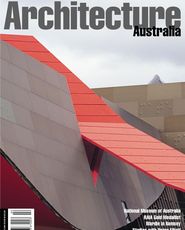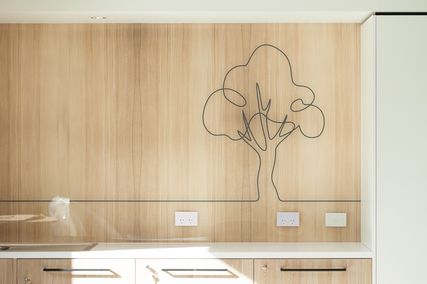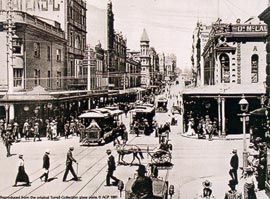
King Street, Sydney, looking east from George Street. Photo Henry King, The Tyrrell Collection, National Library of Australia.
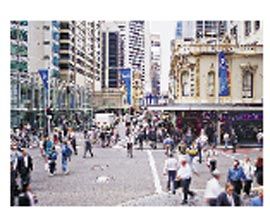
King Street, Sydney, 2000. Photo Brett Boardman, collection of the Museum of Sydney.
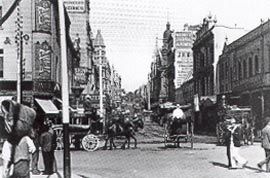
King Street, Sydney, 1892-3. Photo Fred Hardie, George Washington Wilson & Co, Aberdeen, George Washington Wilson Photographic Archive, Aberdeen University Library, Scotland.

Corner of King and George Streets, Sydney, 2000. Photo Brett Boardman, collection of the Museum of Sydney.
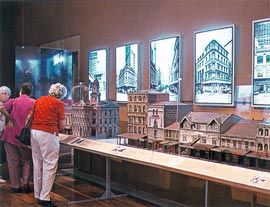
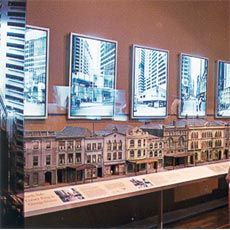
Images of the Sydney @ Federation exhibition installation at the Museum of Sydney. Images show models of 1880s King Street, built by Jack Montgomery in the 1950s and now owned by the Powerhouse Museum. Photos Ross Heathcote.
The texture of the built environment and ›› the people of a city street give individuality ›› to a streetscape and indeed to a whole city.
It is widely believed that Sydney, more than ›› other Australian capitals, has lost so much ›› of its architectural heritage that its urban ›› character has been severely compromised ›› if not substantially destroyed. While there is ›› no disputing the cost of constant city ›› redevelopment, the consequence is not, as ›› is often argued, a cityscape that lacks ›› heritage or pleasure.
A study of one of Sydney’s main city ›› streets – King Street – at the time of ›› Federation and one hundred years on ›› reveals an interaction of disparate periods ›› and elements of the city’s architectural, ›› social and cultural histories. The cumulative ›› result identifies King Street as one of ›› Sydney’s oldest and most historically ›› layered streets.
King Street presents a good opportunity ›› to examine the organisation of urban public ›› space and culture and its metamorphosis ›› in Sydney over 100 years. Named in ›› convict times after Governor King, it has ›› been a major east-west city route for ›› almost two centuries. During the Federation ›› era the street formed three distinct ›› sections. At its western end King Street ›› served the Darling Harbour wharves and ›› warehouses, while the middle section was ›› crowded with retailers, tradespeople, ›› newspapers, lawyer’s chambers and ›› numerous hotels. The imposing buildings of ›› Sydney justice dominated King Street’s ›› upper reach.
Like most city streets of the late 1800s, ›› King Street gathered together a huge variety ›› of people and activities: warehouses, men’s ›› mercers, tobacconists, hotels, confectioners, ›› theatres, shoemakers, barristers and ›› solicitors, auctioneers, druggists, silk ›› merchants, fish and oyster merchants, bread ›› and biscuit bakers. Many people lived above ›› shops and other businesses.
King Street had a reputation for ›› debauchery and drunkenness, hardly ›› surprising given that it boasted twenty-two ›› hotels. The 1887 Royal Commission into ›› Intoxicating Drink was alarmed by King ›› Street: “Among the ordinary customers at ›› these bars are to be found men of all ages ›› and classes; some of them are said to be ›› frequented by supers and ballet girls from ›› the neighbouring theatres, and it is believed ›› that in several cases they are little better, if ›› any better, than houses of assignation” ›› (Royal Commission, p.85).
The former International and Liverpool ›› Arms hotels remain at the Pitt Street corner, ›› still two of the street’s most striking ›› buildings despite chequered retail careers ›› since selling their last drinks during the ›› 1970s. The Theatre Royal is another ›› surviving landmark, albeit in transformed ›› physical form. A theatre site since 1832, the ›› Royal was for decades the centre of ›› Sydney’s commercial theatre district.
King Street’s night life was a magnet for ›› Sydneysiders. By the 1880s the street was ›› also a retail mecca. The clothing trade was ›› the catalyst for the city retail boom. Drapers ›› and milliners, haberdashers and tailors, ›› mercers and glovers – these were the ›› ubiquitous tradespeople and retailers of ›› Federation King Street. Although the ›› production and selling of clothing has ›› changed during the past century, King Street ›› remains a focus for fashion retailers. The ›› diversity and energy of the rag trade is a ›› guarantee of King Street’s continued ›› vibrancy.
Federation King Street was also a major ›› retail and office precinct, sowing the seeds ›› of its transformation during the past century.
Two large office and retail towers, examples ›› of the 1960s and 1970s consolidation of ›› city blocks into “superblocks”, now dominate ›› the north side. NRMA House (formerly the ›› American Express Building) and the MLC ›› Centre project a radically different scale.
However in Culwulla Chambers and the ›› Trust Building King Street boasts two ›› pioneering office towers, as notable for their ›› materials and detailing as for the ›› controversies inspired by their height.
Culwulla Chambers’ encirclement of the ›› former Surrey Hotel (now Louis Vuitton)
emphasises that dramatic differences of ›› scale, style and function existed long before ›› recent city office building booms.
On King Street’s south side much of the ›› architecture of the Federation era survives.
These survivors include the Australian ›› Mutual Fire Insurance Building, one of the ›› first large office buildings constructed on ›› King Street, and the much loved Darrell Lea ›› shop, originally created for Ashdown & Co, ›› “wholesale and furnishing ironmongers”.
Like the facade of the Sydney Arcade, the ›› Darrell Lea shop has been incorporated into ›› a large new office and retail development, ›› while a new arcade behind the Liverpool ›› Arms is an attempt to recapture the intimacy ›› of the Victorian retail genre.
This attempt to highlight, restore and ›› recreate Federation remnants, even as part ›› of larger developments, generates what ›› history had already produced in less ›› considered fashion – the re-evaluation of ›› Federation Sydney and its urban values. It is ›› not coincidental that both John Andrews’ ›› American Express building and Harry ›› Seidler’s MLC building have been revamped ›› amid controversy to enhance pedestrian ›› access and street level prospect. Combined ›› with a typically narrow and irregular Sydney ›› roadway, King Street’s architectural ›› juxtapositions can provide a heady urban ›› experience.
Sydney @ Federation focuses on the ›› middle section of King Street, from George ›› Street to Castlereagh Street. The exhibition ›› features models of King Street made by ›› Jack Montgomery, a model maker for the ›› ABC, during the 1950s. These were later ›› owned and displayed by Sydney City Council ›› before being acquired by the Powerhouse ›› Museum. Together with Federation ›› photographs by Kerry & Co and ›› contemporary images by Brett Boardman ›› they form a detailed picture of change in the ›› city of Sydney.
Caroline Butler Bowden, along with Caroline
Mackaness, is the curator of Sydney @
Federation. The exhibition runs at the
Museum of Sydney until June 17

